This self-inflating 4" thick sleeping pad will keep you off the hard surface, and you won't touch the ground no matter how you flip. It comes with an ergonomic one-piece pillow and a foot pump to be inflated in less than 2 minutes.
Not suitable for cold weather.
The eco-friendly TPU materials that are durable and tear-resistant make this compact sleeping pad ideal for harsh environments, mountain hiking, and outdoor adventures.
Double Sleeping Pad
79 x 55 inches
~60°F
40D Nylon
TPU film
40D nylon
30" x 7" x 7"
5.44 pounds
1 year
30 days
10°F
10 years limited
This lightweight, small, and incredibly comfortable sleeping bag is made of environmentally friendly materials. It features two sliding zippers with an anti-snag tube.
Not a lot of room for heavier people.
Kelty comes with a convenient pocket for a cell phone or a flashlight. It will be useful for those that like to read a book or newsfeed before going to bed. The stylish design will appeal to female customers.
One-Person Mummy Bag
15.8 x 7.7 inches
20°F
Nylon
50D Polyester Taffeta
Nylon
12" x 8.3" x 7.8"
3 pounds
30 days
A very warm and portable sleeping bag for hiking or camping. Can be used as one large queen-size sleeping bag or as 2 separate sleeping bags.
The included pillows are uncomfortable.
The outer shell is made of heavy-duty waterproof polyester camping fabric. The lining creates a cozy atmosphere inside. With a compact carry bag, this product can be taken on any trip.
Double Sleeping Bag
87 x 59 inches
32°F
210T Polyester
Cotton
Tetron and Cotton
17.1" x 13.8" x 6"
3 pounds
Lifetime warranty
This site is a free online resource that strives to offer helpful content and comparison features to its visitors. Please be advised that the operator of this site accepts advertising compensation from certain companies that appear on the site, and such compensation impacts the location and order in which the companies (and/or their products) are presented, and in some cases may also impact the scoring that is assigned to them. The scoring that appears on this site is determined by the site operator in its sole discretion, and should NOT be relied upon for accuracy purposes. In fact, Company/product listings on this page DO NOT imply endorsement by the site operator. Except as expressly set forth in our Terms of Use, all representations and warranties regarding the information presented on this page are disclaimed. The information which appears on this site is subject to change at any time. More info
Elegear Double
Your Ultimate Comfort
Hikers and campers, get ready to take notes. Elegear sleeping pad for 2 people is like a dream come true; it’s thicker, self-inflating, and damage-resistant. Let’s take a closer look at why this product is so great.
Measuring 79" x 55" x 4" upon inflation, this sleeping pad never lets you feel the hard ground or rocky surface. It’s just as comfy as your home mattress even if you are taller, heavier, or flip a lot. Get prepped for a whole new camping experience with Elegear.
What makes this sleeping pad stand out is the unique drawstring body support technology. It disperses gravity with ease and provides the increased weight-bearing capacity of up to 800 lbs. With all that, it’s not too thick and looks really stylish. Two adults or one grown-up with two kids will fit right onto the pad with no problem. Elegear is perfect for a couple’s getaway trip or an outdoor family picnic.
Forget about the strain on your neck with this pad. It features a comfortable one-piece pillow to support your head while you’re resting. Just imagine the relief after a long hike when you can lie down and relax without having to search for a perfect position.
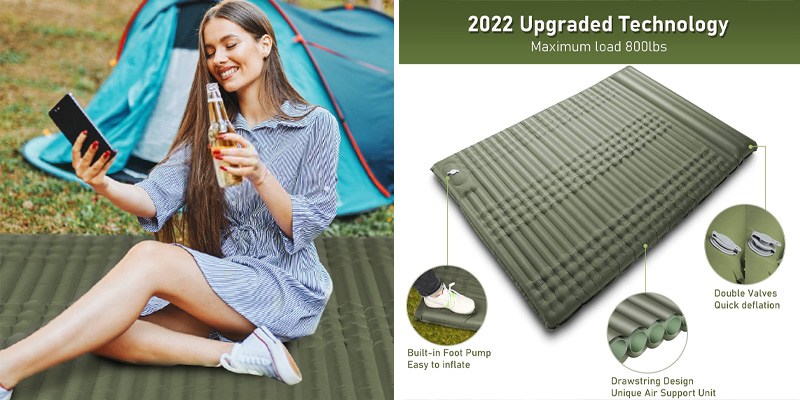
Self-Inflates in a Flash
No need to carry an extra pump in your backpack. Elegear is equipped with an extra-handy integrated foot pump. Yes, it takes some leg workout – and following instructions – but with good effort, you’ll be able to inflate your pad in less than 2 minutes. Note that this will take longer if you don’t press at the maximum speed. The system is much faster and safer than the traditional mouth blowing.
Great, but what about deflating this huge sleeping pad? Don’t worry, it’s super quick thanks to the 2 double-layer pillow valves. They also effectively prevent the air leakage even when the pad is fully occupied. After deflating, it can be folded back into a stylish branded bag.
Elegear is one tough camping pad with ultra-thick 40D nylon and eco-friendly materials. It’s waterproof and doesn’t tear or get punctured easily. All the more reasons to take it on demanding hiking journeys. Keep in mind, though, that it’s not designed for cold and harsh weather conditions.
This 5.5 lbs. pad will accompany you on camping or car trips like it’s not even there.
If you’re looking for a couple’s or family sleeping pad solution, Elegear is easily one of the best – and comfiest – options.
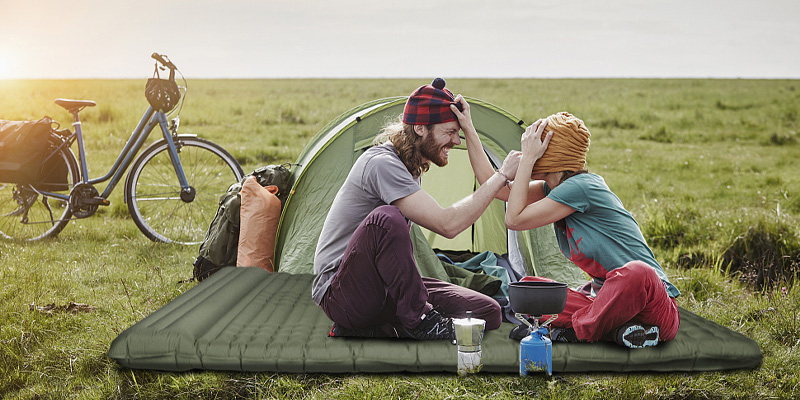
| Last updated price | $0.00 |
| Stock | In stock |
| ASIN | B09Q2TV3KD |
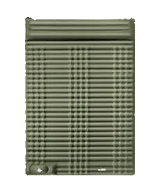
Black Pine Grizzly
Temperature Ratings
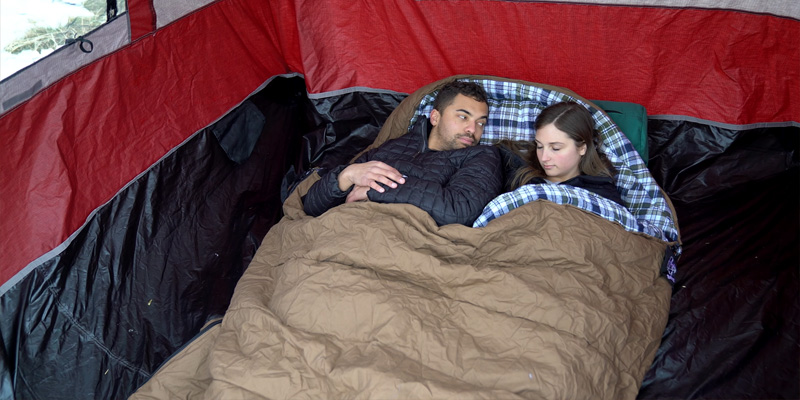
Shape
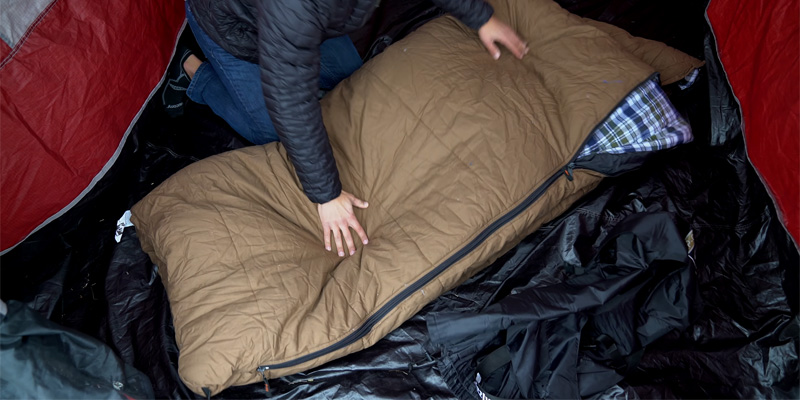
Materials
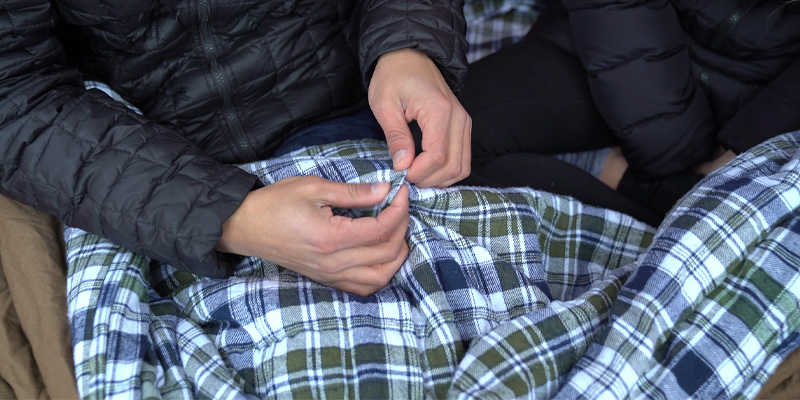
Convenience
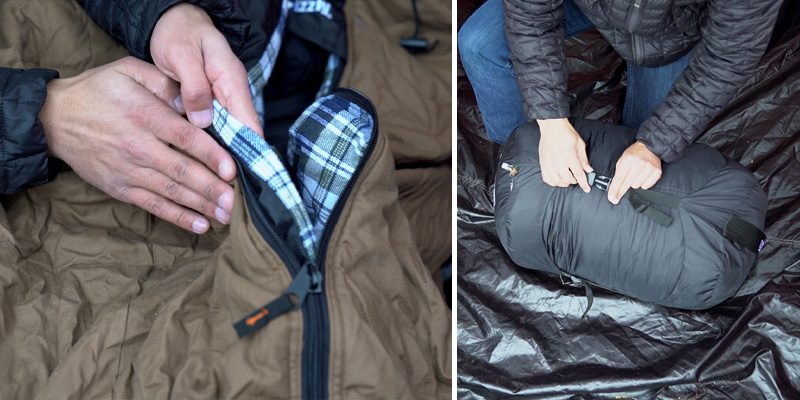
| Last updated price | $0.00 |
| Stock | May be out of stock |
| ASIN | B019UT76RG |
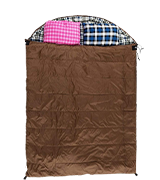
Coleman North Rim
Temperature Ratings
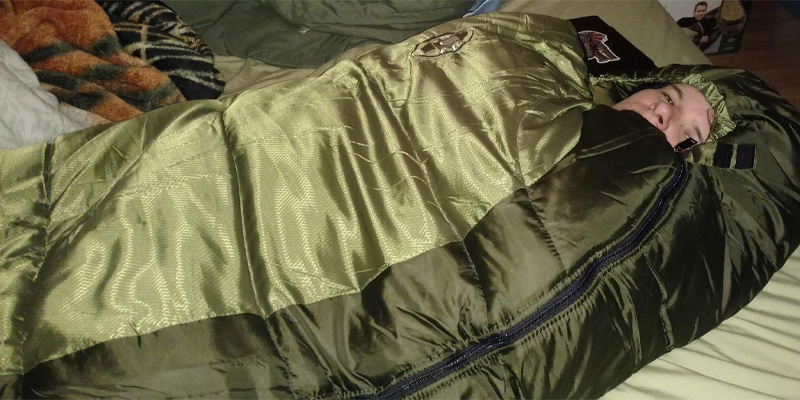
Shape
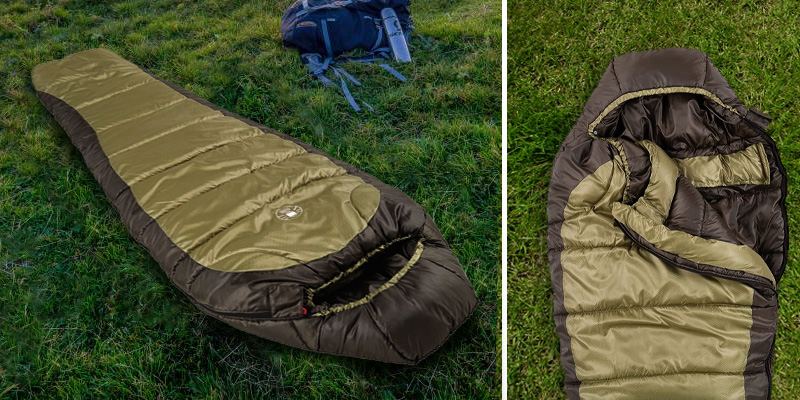
Materials
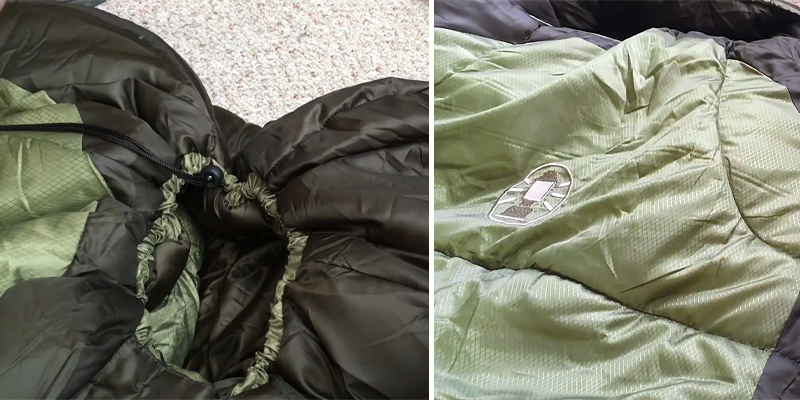
Convenience
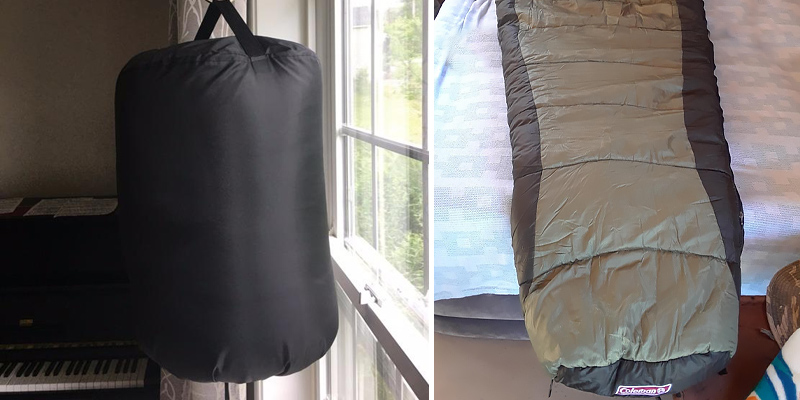
| Last updated price | $49.99 |
| Stock | In stock |
| ASIN | B0009PUSO4 |
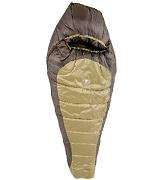
Kelty Cosmic 20 Degree 550 Down Fill
A Sleeping Bag That Will Surprise You
Hiking trips are great… but excessive baggage is most probably not. Kelty sleeping bag is designed to be small, lightweight, and mood-boosting. It’s aptly called “Down Fill” to not let your trip go “downhill”.
This sleeping bag may look funny with its cocoon shape at first. In reality, the trapezoidal baffle construction helps retain the heat inside. Perfect for hiking or camping, this bag will keep you warm and cozy with the 20 °F temperature rating. Say “bye” to ineffective products that make you feel like you’re in that scene from “Shining”.
Kelty packs really small, and you can buy a compression sack for it separately. It can accommodate a person of up to 6'6" height, although if you’re on the heavier side, this might not be the best choice for you. Also note that the foot area is not too big, which is to be expected with such a slim design for this model.
The bag features 550 fill DriDown insulation and is easy to dry and keep. But that’s not all; the PFC-free coating is water repellant for your boosted sleeping comfort. Kelty love the environment just as much as they love you.
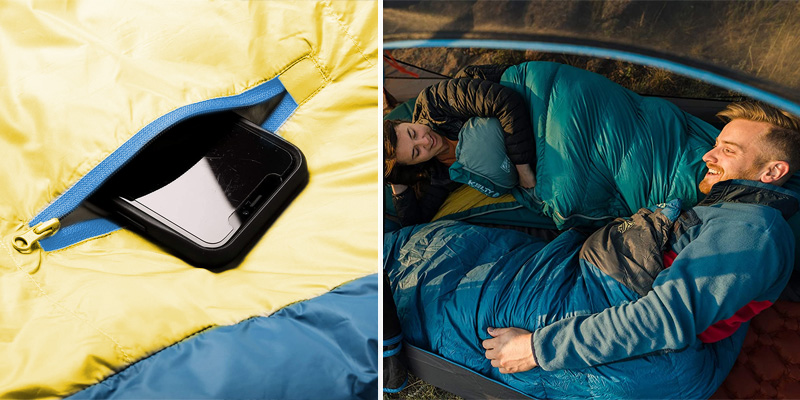
Always Convenient, Not Overpriced
This sleeping bag offers upscale quality at an affordable price. It’s great for the beginners that don’t want to overpay for something they don’t really need. However, veteran campers and hikers will also find this bag a welcome addition to their load.
Never worry about the zippers. You won’t get deadlocked in a Kelty bag with the two sliding and locking ones plus a convenient anti-snag draft tube. Feel free to unzip the bag from the bottom to free your feet – or regulate the heat to keep yourself super comfy.
Taking your smartphone on a trip? It won’t get lost in the depths of this sleeping bag thanks to the zippered inside phone pocket. Though, if your cell friend is a big one, you might have trouble fitting it in.
Is this bag good for the actual cold weather? The happy customers testify that extra cold nights in unheated cabins or on Alaska trips didn’t bother them at all. Great news for real adventurers; but if you just need the bag to spend a comfy night by a local lake, no problem. Kelty is versatile and doesn’t limit your experience.
Overall, this sleeping bag is a prime example of great value for your money.
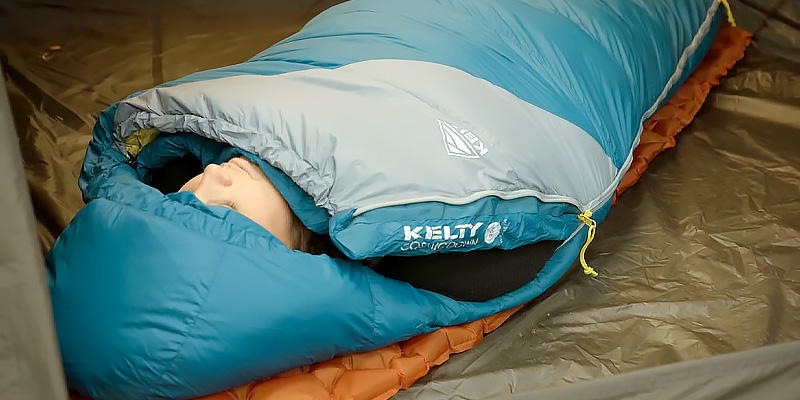
| Last updated price | $0.00 |
| Stock | In stock |
| ASIN | B08MJLN8PJ |
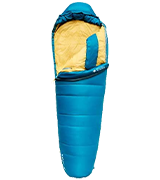
Sleepingo Double
A Double Wonder
Want to get really, really warm on your winter hiking trip? Sleepingo surely knows how to make this happen. It’s extra warm, conveniently soft, and can be split in two individual bags.
Let’s start with the fact that Sleepingo is 87 x 59" to fit in two adults and possibly an extra kid. Get romantic on a car trip in the country – or get cozy in a remote cabin in the woods. This sleeping bag has got you covered, whatever you do or wherever you decide to go. Still, if you’re not buying it for cuddling with your crush, simply unzip the bag all the way around, and now there’s two of them.
Sleepingo excels at keeping out the annoying cold. Enjoy the amazing 32° temperature rating – and don’t give that winter weather any chance to disappoint you. This bag is your best companion for extra cold nights out and will safeguard your sleep by keeping you perfectly warm.
This handy bag also comes with 2 travel pillows, which is a nice bonus from the manufacturer. Note, however, that they could be more convenient, so you might want to pack some other pillows instead. Try slipping into the bag at home and checking out your options before the trip.
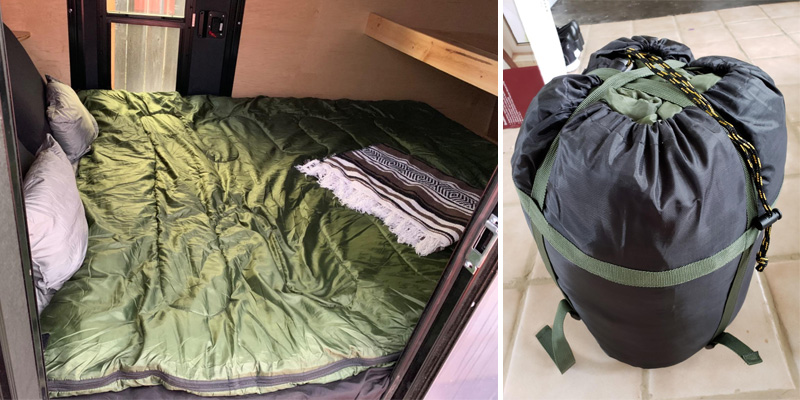
Reliable and Super Portable
Rain or snow, Sleepingo is always up the mark. It doesn’t let bad weather spoil your trip, having an extra strong waterproof outer shell made of high grade polyester. With 210 thread count for a square inch, this sleeping bag will serve you even under harsh weather conditions. Perfect for veteran hikers or campers – and reliable for beginners, this product will surprise you with its quality.
As for the inner lining, get ready for the next level of coziness. This bag combines tetron and cotton for your body comfort and sweet dreams at night. Also, you won’t get overheated like in a stuffy, narrow “mummy bag”. Sleepingo lets you spread out or starfish while keeping you steadily warm.
Many double bags are a packing nightmare… but not this one. It’s really lightweight and foldable up to 15x12" into a compact carrying case. You won’t be noticing you even have it on until unpacking and thoroughly enjoying a good night’s sleep.
Bag has got a little dirty on the trip? No worries; machine wash it using the instructions, and it will come out just fine.
Summing up, this double sleeping bag is a great find for romantic couples and avid winter campers.
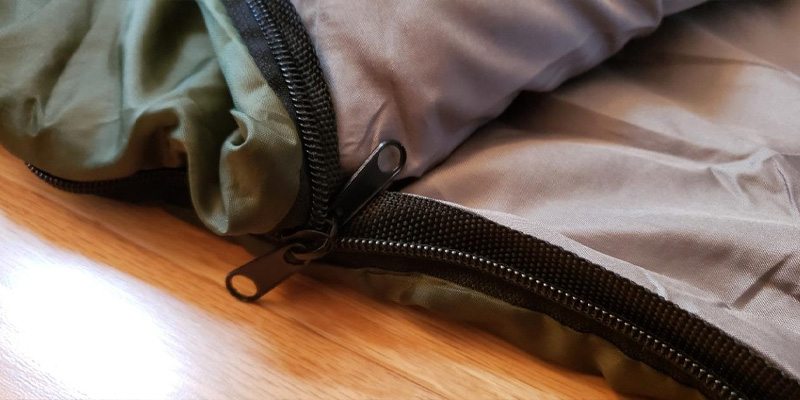
| Last updated price | $0.00 |
| Stock | In stock |
| ASIN | B01LXK5T5Z |
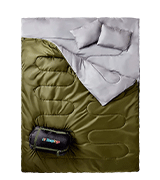
Infographics
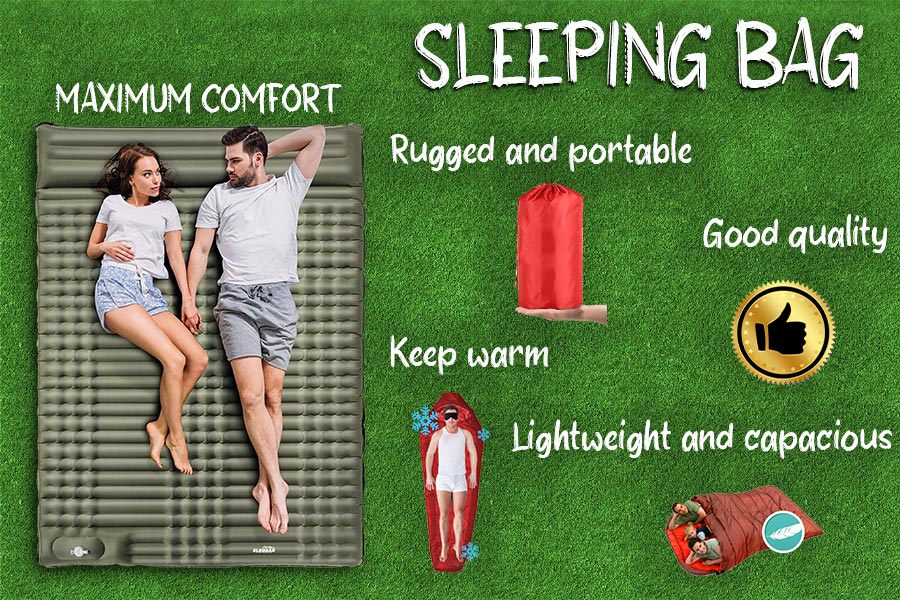
What is a Sleeping Bag
Are you a passionate camper? Or do you enjoy camping overnight on occasion? Don’t forget to bring your sleeping bag! Camping is all about having a good time and getting lots of positive emotions, so don’t let a bad sleep ruin the mood. Sleeping bags are essential gears for every camper who wants to sleep warm and comfortably. They let you sleep, relax and recover your strength and protect you against overcooling at night. In our sleeping bags review, we focus on what to look for when choosing these essential camping gears and share our shortlist of the best sleeping bags for your warm, comfortable sleep!
For people, traveling a lot, we recommend reading our reviews on camping stoves and headlamps that both can help make your outings more enjoyable.
What Features to Compare
Choosing a sleeping bag is a relatively simple task if you know exactly where, when, and what for you’re going to use it.
The Temperature Ratings of a sleeping bag is the first parameter we recommend paying attention to. Most manufacturers rate their sleeping bags to help you choose the right one for your preferred season and weather. For example, 4-season sleeping bags with comfort ratings of −25 degree F will keep you warm on a cold winter’s night. 3-season sleeping bags (often rated as 0-degree sleeping bags) will suit for a comfortable outdoor sleep in spring, summer or autumn. The bags rated +25 Degree F will be perfect for summer camping.
The Shape of a sleeping bag is another important parameter. The two most popular types in the market are rectangular, i.e. ‘blanket’ sleeping bags, and tapered, hooded sleeping bags, so-called “Mummy bags”. Rectangular sleeping bags can be zipped from the very top to the very bottom, they can be unzipped completely and used as a comforter or a blanket. These sleeping bags are well suited for simple camping trips, or for people who travel by car. They can also be zipped together with some other sleeping bags for more room. Mummy-type sleeping bags are tapered to the bottom and don’t unzip completely. Thanks to their anatomical shape, such sleeping bags are lightweight and compact, they also retain warmth very well. Mummy bags are hooded, keeping your head warm and protecting you against cold drafts. You might need some time getting used to sleeping in mummy-type sleeping bags, as they aren’t as roomy as rectangular ones. Also, note that some sleeping bags allow connecting two bags. Just zip your two sleeping bags together to cuddle up and sleep comfortably. Just remember to pay attention to the zippers, there are left-side and right-side sleeping bags. Mummy-type sleeping bags are well-suited for backpacking, hiking or mountaineering due to their light weight and great insulation capabilities.
The Materials used in sleeping bags determine where and in what conditions you can use them. Most sleeping bags have a durable outer shell and a softer lining, and are filled with an insulation material. All the materials in sleeping bags must serve to retain warmth and provide comfort to their owners, they have to be both strong and lightweight. The outer shell must be breathable, wear- and water-resistant. Polyester and nylon are most often used for outer shells, keeping the cold weather out. The inner lining must also be breathable and soft, allowing you to sleep comfortably with no excess sweating. Manufacturers generally use cotton, flannel, fleece and nylon fabrics. Insulation fillers are made of quilted natural or synthetic fiber materials. Down sleeping bags provide great warmth insulation. However, the down can shift sometimes, and if a sleeping bag gets wet it might take a long time to dry. Synthetic fillers dry quickly because they do not absorb moisture. Sleeping bags with synthetic fiber insulation are well-compressible and restore their shape quickly, you can even wash them in a washing machine. Durable polyester fibers, having a structure similar to natural down and leaving no cold spots, are distinctive features of best sleeping bags.
Convenience, as regards transportation and use, is a very important thing to consider before you buy your camping gears. The lighter your sleeping bag is, the less trouble you will have taking it with you. Most sleeping bags come with a stuff sack which allows you to compress your bag and free extra space for your other gears. To choose the right sleeping bag to fit you comfortably, add about 6-8 inches to the height and width of your body. For example, children’s sleeping bags have an average size of 28 x 57 inches, teenage bags are usually 28 x 57 inches, the standard adult size is about 29” x 75” or more, and there are larger sleeping bags of about 33 x 78 inches. If you’re traveling with your family, you might want to give a try to double sleeping bags which fit two people comfortably. Also, pay attention to the additional features, such as convenient zippers, inner pockets, and other extras which will facilitate the use of your sleeping bag.


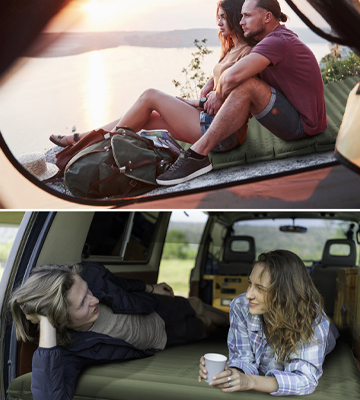
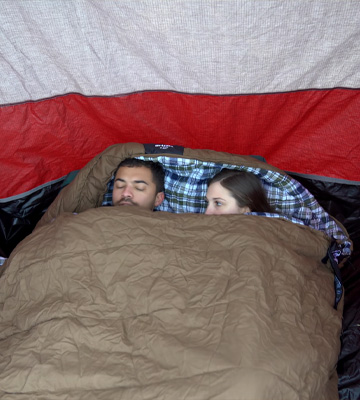
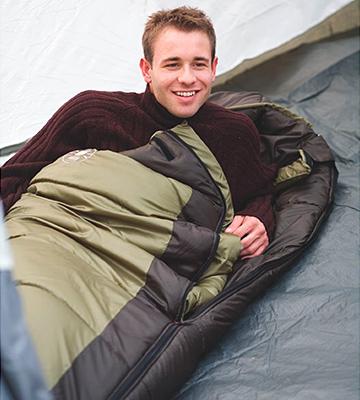
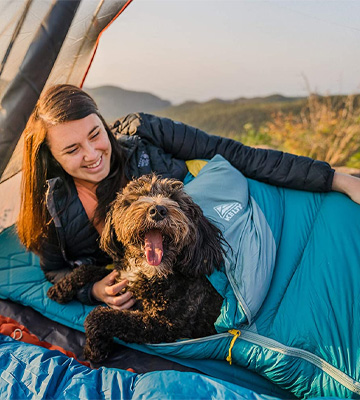
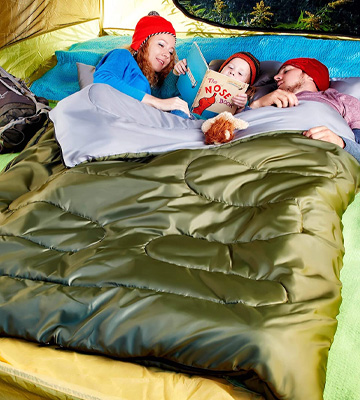

Your comment was successfully sent
Error! Please try again later